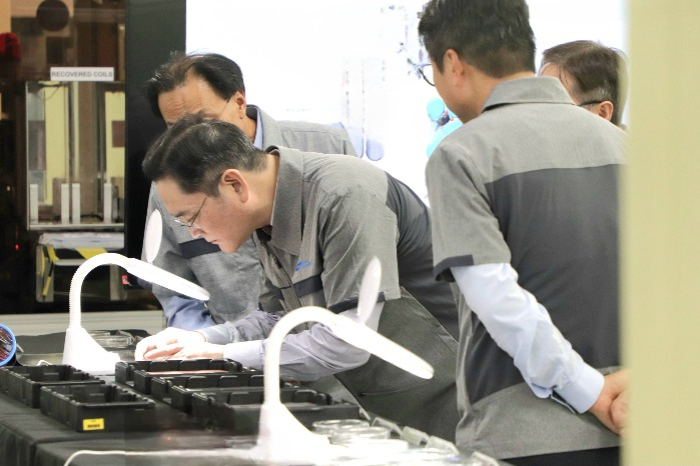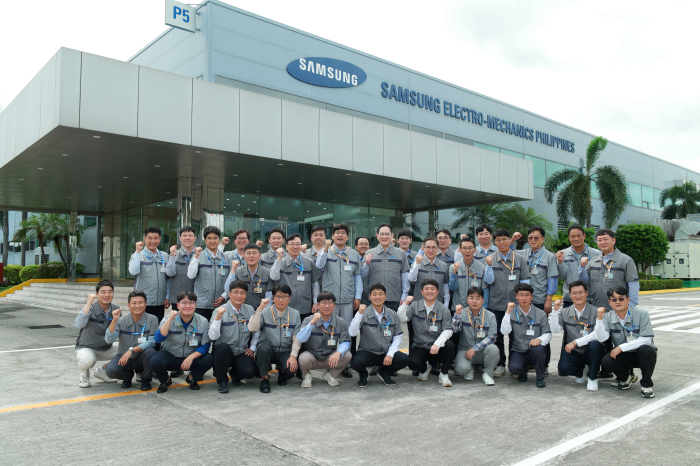Samsung's Lee inspects MLCC plant in Philippines as it eyes turnaround
Samsung Electro-Mechanics is targeting 1 trillion won ($742 million) in MLCC sales in 2024 and market leadership in auto semiconductor parts
By Oct 07, 2024 (Gmt+09:00)
LG Chem to sell water filter business to Glenwood PE for $692 million


KT&G eyes overseas M&A after rejecting activist fund's offer


Kyobo Life poised to buy Japan’s SBI Group-owned savings bank


StockX in merger talks with Naver’s online reseller Kream


Meritz backs half of ex-manager’s $210 mn hedge fund



Samsung Group Chairman Jay Y. Lee on Sunday inspected Samsung Electro-Mechanics Co.’s production facilities for multilayer ceramic capacitors (MLCCs) in the Philippines. Lee's visit comes as the company strives to lead the market in automotive semiconductor parts alongside an electric vehicle and autonomous driving market expansion.
The company operates two factories in the Philippines, which serve as one of the company’s two overseas production bases, along with one in Tianjin, China. Its two domestic plants in Suwon, Gyeonggi Province, and the southeast port city of Busan focus on research and development.
MLCCs act as dams that charge and discharge certain amounts of electricity to control flow and are regarded as the rice of the electronics industry.
They are critical to the stable operation of electrical and electronic circuits used in EVs and self-driving cars, as well as in smartphones and the Internet of Things (IoT).
Samsung Electro-Mechanics has been rolling out MLCCs used in advanced driver-assistance systems, anti-lock braking systems and power trains in the Philippine city of Calamba since 2000.
It built a second plant there in 2012 and added production lines with an investment of 288 billion won in 2015 to foster its MLCC business as a growth engine.

The MLCC market is projected to grow to 9.5 trillion won by 2028, more than double the 4 trillion won in 2023, according to industry observers.
Around 1,000 MLCCs are embedded in a typical IT product, while from 3,000 to 20,000 MLCCs are installed in EVs. Automotive MLCCs are more than three times as expensive as others.
Lee visited the plant as part of the business delegation accompanying Korean President Yoo Suk Yeol’s state visit to the Southeast Asian country.
This year, Samsung Electro-Mechanics is expected to make a business turnaround after suffering a 46% plunge in operating profit in 2023 from the year prior.
The launch of the 2024 Galaxy smartphone lines by Samsung Electronics Co. is contributing a great deal to its sales growth.
Samsung Electro-Mechanics is targeting 1 trillion won ($742 million) in sales of automotive MLCCs in 2024. Comparative figures for previous years are not available.
In 2025, it is aiming at 2 trillion won in sales from automotive components, including MLCCs, carmera modules and semiconductor package substrates.
Write to Chae-Yeon Kim at Why29@hankyung.com
Yeonhee Kim edited this article
-
 ElectronicsKorea Investment lowers price target for Samsung Electro-Mechanics
ElectronicsKorea Investment lowers price target for Samsung Electro-MechanicsSep 30, 2024 (Gmt+09:00)
1 Min read -
 AutomobilesSamsung Electro-Mechanics to supply hybrid camera lenses to Hyundai
AutomobilesSamsung Electro-Mechanics to supply hybrid camera lenses to HyundaiMar 10, 2024 (Gmt+09:00)
4 Min read -
 ElectronicsSamsung Electro-Mechanics eyes turnaround with Galaxy AI
ElectronicsSamsung Electro-Mechanics eyes turnaround with Galaxy AIJan 10, 2024 (Gmt+09:00)
1 Min read -
 ESGSamsung Electro-Mechanics joins global supply chain consortium RBA
ESGSamsung Electro-Mechanics joins global supply chain consortium RBAJul 12, 2023 (Gmt+09:00)
1 Min read -
 Electric vehiclesSamsung Electro-Mechanics unveils high-capacity MLCCs for EVs
Electric vehiclesSamsung Electro-Mechanics unveils high-capacity MLCCs for EVsMay 16, 2023 (Gmt+09:00)
2 Min read -
 Korean chipmakersSamsung's Lee visits growth driver MLCC China plant
Korean chipmakersSamsung's Lee visits growth driver MLCC China plantMar 27, 2023 (Gmt+09:00)
2 Min read -
 ElectronicsSamsung Electro-Mechanics releases 200-megapixel camera module
ElectronicsSamsung Electro-Mechanics releases 200-megapixel camera moduleMar 20, 2023 (Gmt+09:00)
1 Min read -
 Korean chipmakersSamsung Electro-Mechanics unveils chip substrate for autonomous driving
Korean chipmakersSamsung Electro-Mechanics unveils chip substrate for autonomous drivingFeb 27, 2023 (Gmt+09:00)
2 Min read -
 Corporate strategySamsung Electro-Mechanics to focus on IT, automotive electronics sectors
Corporate strategySamsung Electro-Mechanics to focus on IT, automotive electronics sectorsMar 10, 2022 (Gmt+09:00)
1 Min read -
 AutomobilesSamsung Electro-Mechanics aims to take lead in MLCC market
AutomobilesSamsung Electro-Mechanics aims to take lead in MLCC marketAug 13, 2021 (Gmt+09:00)
1 Min read -

-
 Samsung Electro-Mechanics poised to benefit from Huawei’s troubles, rising demand for MLCCs
Samsung Electro-Mechanics poised to benefit from Huawei’s troubles, rising demand for MLCCsSep 09, 2020 (Gmt+09:00)
3 Min read


